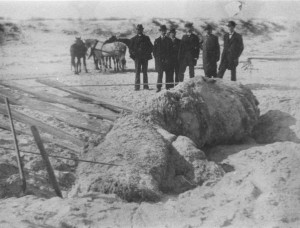by Jack El-Hai, Wonders & Marvels contributor
Imagine you are a boy bicycling along the beach with a friend on a cool November evening on Anastasia Island, Florida. Perhaps you stop to examine shells, driftwood, and small burrowing crabs. Then, unexpectedly, you see looming at the shoreline, partly buried in the sand, an enormous something…a mass of flesh…a monster.
Dunham Coretter and Herbert Coles together made such a grotesque find in 1896. Whatever it was — and its youthful discoverers suspected it was the remains of a whale — the creature was greatly decomposed. The boys notified DeWitt Webb, a naturalist in nearby St. Augustine, who wasted no time in trekking to Anastasia Island.
A globster
Today we call this sort of unidentified washed-up biomass a globster, and beachcombers and fishermen have chanced upon many of them over the centuries. (The Montauk Monster, for instance, appeared on a New York beach in 2008.) Webb found what he described as a pale carcass bearing the remains of tentacles. Its texture was very tough and almost impossible to cut with a knife. He measured its visible length at six meters and its width at 2.5 meters, and he estimated its weight at five tons. Webb preliminarily identified it as the remains of a giant octopus.
Other people, including the owner of a nearby hotel, made their own observations. Many confirmed that the beached creature had arms, and some even saw a head “as large as an ordinary flour barrel” that resembled the head of a sea lion. Partial excavations of the creature from the sand showed it to be much larger than Webb had previously measured.
Weeks later the globster was still embedded in the sand, but a January storm pulled the carcass back into the sea. It soon reappeared on a beach two miles away. Webb took numerous photos of the hulk and sent them to various zoologists. Speculation on its origins ranged from squid to sperm whale to extinct sea monster. With difficulty and a team of six horses, Webb managed to haul the carcass away from the beach to a more protected spot, where it became a spectacle for tourists. The remains eventually rotted away or vanished, and its ultimate fate remains unknown.
Octopus or whale?
Before that disappearance, however, Webb had sent a specimen from the globster to William Healey Dall at the Smithsonian Institution. That sample sat forgotten in the Smithsonian’s archives for decades, until interest in it reignited in the 1970s. A 1971 study of the specimen declared it part of an octopus, a determination agreed upon 15 years later by another investigation. During the 1990s, the application of new technology cast that identification in doubt. Finally in 2004, DNA analysis confirmed that the biomass consisted of a massive sheet of collagen that had, in life, belonged to a whale.
The boys who discovered the St. Augustine Monster 108 years earlier had been right about it all along.
Further reading:
Broad, William J. “Ogre? Octopus? Blobologists Solve an Ancient Mystery.” The New York Times, July 27, 2004.
Ellis, Richard. Monsters of the Sea. Lyons Press, 2000.

